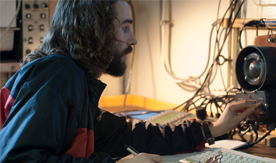
Briggs Headed to France to Explore Marine Snow in the Twilight Zone
Studying the movement of carbon dioxide into the deep ocean to improve climate projections and understanding of deep-sea ecosystems will be the focus of a two-year research project by a University of Maine marine scientist.
Feb. 1, Nathan Briggs begins a two-year postdoctoral fellowship research project in France that’s funded, in part, by a $194,000 grant from the National Science Foundation (NSF). He will collaborate with Hervé Claustre, a senior scientist at Laboratoire d’Oceanographie de Villefranche (LOV) on the Mediterranean Sea.
Climate change may alter patterns of carbon movement in the mesopelagic ocean layer (depths ranging from about 300 feet to 3,000 feet), Briggs says. And the change in patterns could result in climate feedbacks (magnification or lessening of the change) and/or threaten deep ecosystems.
The mesopelagic layer, sometimes called the twilight zone because the light that penetrates to this depth is so faint, plays an important role in the long-term storage of atmospheric carbon dioxide, he says.
Carbon dioxide that reaches the bottom of this zone remains trapped in the ocean for hundreds to thousands of years.
Briggs’ research will focus on “marine snow” — clumps of organic matter that form in the surface ocean and drift through the twilight zone like falling snowflakes, taking carbon with them.
The 10-day or so journey through the twilight zone is a dangerous one for a marine snow particles, Briggs says. They are a major food source for giant squid and other creatures, — some of which are bioluminescent — in the twilight zone, which is too dark to produce its own food.
The amount of marine snow that makes it through and the amount of carbon dioxide trapped in the deep ocean depend on the sinking speed of marine snow, as well as its “palatability,” and the population of consumers waiting for a meal to sink from above, he says.
Briggs became interested in marine snow during a 2008 research cruise south of Iceland led by his UMaine graduate adviser, Mary Jane Perry.
Researchers deployed low-power underwater robots to explore the twilight zone. The robots carried particle sensors designed to detect concentrations of microscopic plankton.
The researchers observed a large bloom of microscopic algae at the surface and suddenly the particle sensors in the twilight zone appeared to go haywire, periodically jumping to abnormally high readings, then immediately returning to normal, Briggs says.
While some scientists initially thought the instruments were malfunctioning, Briggs says Perry suspected the abnormal readings were caused by marine snow particles, which are hundreds of times larger than the microscopic particles that the sensors were designed to measure.
Perry tasked Briggs with further investigation. In 2010, he was awarded a fellowship from NASA and later he received a UMaine doctoral research fellowship to develop and test methods for using underwater robots to measure marine snow.
The work paid off. With Perry and other collaborators at UMaine and the University of Washington, Briggs demonstrated the high particle readings in 2008 were indeed caused by marine snow. And he used the readings to estimate how much carbon the marine snow carried to the deep ocean.
In his new position, Briggs will use the techniques he developed at UMaine to track marine snow on a much larger scale.
Briggs, whom the NSF refers to as a promising scientist, will conduct the two-year research project with Claustre, who operates a fleet of more than 50 underwater robots deployed across the North Atlantic Ocean (one is 800 miles off the Maine coast), the Mediterranean Sea and the Southern Ocean that circles Antarctica.
Briggs says the robots are producing the richest dataset in the world for scaling up his robotic analysis of marine snow, and he’s thrilled to be joining Claustre’s team.
The feeling is mutual. Claustre says Briggs, “will bring valuable experience in analyzing large, bio-optical datasets acquired by autonomous platforms, including the specific, innovative methods he has developed…” to the French team.
Information gleaned from Briggs’ research will inform future sampling strategies. As the robotic fleets of Claustre and others expand to form a permanent, global network, this research will be the start of a global, on-site record of marine snow in the underexplored twilight zone.
The research project, titled “Tracking mesopelagic carbon flux and particle size on a multi-ocean scale using a fleet of bio-optical profiling floats,” was submitted to the Ocean Sciences Postdoctoral Research Fellowship program.
Funding from the Office of International and Integrative Activities also supports the award.
Contact: Beth Staples: 207.581.3777
